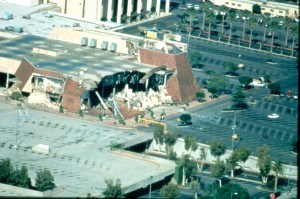

A recent poll by the Insurance Information Institute (I.I.I.) found that only one out of 10 American homeowners (10 percent) have earthquake insurance, compared with 13 percent in 2012. In western states, 22 percent of homeowners said they have earthquake insurance, down from 27 percent.

“When the Northridge earthquake happened 20 years ago, we estimated that nearly 29 percent of homeowners in California had earthquake coverage,” said Pete Moraga with the Insurance Information Network of California (IINC). “However today, according to the California Department of Insurance, only about 10.6 percent of homeowners have the coverage.”
“While the number of people buying earthquake insurance has declined, the potential cost of U.S. earthquakes has been growing because of increasing urban development in seismically active areas and the vulnerability of older buildings, which may or may not have been built or upgraded to current building codes,” said Dr. Robert Hartwig, CPCU, an economist and president of the I.I.I.
The I.I.I. reports that since 1900, earthquakes have occurred in all 50 states across the country. The August 11, 2011, quake in Mineral, Virginia, for instance, was felt throughout much of the East Coast. And as recently as January 9, of this year, a 5.1 magnitude earthquake off the Cuban coast shook buildings and rattled Florida residents from the Keys to Orlando.
The 6.7 magnitude quake with an epicenter of about 20 miles, which hit Los Angeles on January 17, 1994, was the costliest U.S. earthquake, causing $15.3 billion in insured damages (about $24 billion in 2013 dollars). It ranks as the fourth-costliest U.S. disaster, based on insured property losses (in 2013 dollars), topped only by Hurricane Katrina, the attacks on the World Trade Center and Hurricane Andrew.
According to AIR Worldwide, the previously unknown blind reverse-thrust fault rupture produced the largest ground motions ever recorded in an urban environment in the U.S., and heavily damaged more than 40,000 structures across several counties.
While there has not been a major quake on the U.S. mainland since Northridge, California, remains the state most at risk. Powerful earthquakes are more likely to occur in southern California than in northern California over the next 30 years, according to a 2008 study compiled by experts from the U.S. Geological Survey and USC’s Southern California Earthquake Center. Six of the 10 costliest U.S. quakes, based on insured losses, were in California, according to Munich Re.
“Insurers paid out more for Northridge claims than they had collected in earthquake insurance premiums in the preceding 30 years,” explained Hartwig. “While the cost of insurance has increased since Northridge, it’s important that home and business owners in California and other vulnerable areas consider purchasing earthquake coverage, which is the fastest and most efficient path to recovery.”
Earthquakes are not covered under standard U.S. homeowners or business insurance policies. Coverage is usually available for earthquake damage in the form of a supplemental policy from private insurance companies. In California, homeowners can secure coverage from the California Earthquake Authority (CEA), a privately funded, publicly managed organization, established in 1996, as well as from private insurers. The CEA does not offer coverage for commercial, industrial or business properties.
According to AIR Worldwide, the CEA was intended to be a permanent solution to California’s earthquake insurance cover issues, but the percentage of California homeowners who have coverage is currently only about 12 percentage. The CEA bears a little over two-thirds of this risk.
Source: I.I.I./AIR Worldwide